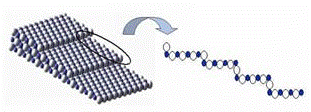Chemistry, Department of: Faculty Series

Marjorie A. Langell Publications
Document Type
Article
Date of this Version
May 1997
Abstract
We have studied the thermal interactions of acetone and acetaldehyde on Si(100), both sputtered and annealed, using high resolution electron energy loss spectroscopy, (HREELS), x-ray photoelectron spectroscopy (XPS), and temperature programmed desorption (TPD). There is no carbonyl stretch in HREELS and the C and O(1s) XPS peaks reflect two different carbonyl processes, one involving bond cleavage, the other a reduction of the C–O bond order. Hydrogen TPD gives a peak at 840–850 K which is as much as threefold more intense than from H-saturated Si(100). SiO desorbs near 1050 K and XPS shows total loss of oxygen and retention of carbon. Approximately 34% of the acetaldehyde monolayer and 62% of the acetone monolayer decomposes on annealed Si(100) to produce silicon carbide. In contrast, after sputtering with 500 eV Ar ions, these percentages are reduced to 14% and 25%, respectively. We conclude that Si dimers play an important role in the chemistry of carbonyl groups.


Comments
Published by American Vacuum Society. J. Vac. Sci. Technol. A 15(3), May/Jun 1997. ©1997 American Vacuum Society. Permission to use.